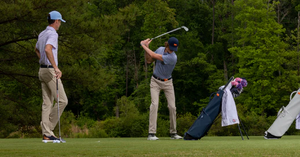What Is Wedge Bounce?
In the world of golf, many different clubs can massively alter your game - for the better if you use them wisely and for the worse if you use them without knowing their true purpose. Understanding wedges and wedge bounce is crucial to getting the most out of your game.
So let's uncover together precisely what wedge bounce is and, almost more vitally, why manufacturers have designed wedge bounce to make your next round the best yet!
Wedge Bounce Explained
Before you think about wedge bounce, let's discuss what a wedge is. Wedge bounce is the name of the angle between the sole (the bottom of the club) and the club's leading edge.
If the sole still perplexes you, think of the part of your club face that hits and will move through the ground, grass, or turf when you hit the golf ball. The sole is the area that will help you attain good contact, spin, and control when hitting the ball.
The more angle between the sole and the leading edge, the more bounce a wedge has, meaning the leading edge is higher off the ground. Difference degrees of wedge bounce will affect your game, so it’s crucial to understand how it works.
Types of Wedges
Low Bounce Wedges
You'll use low-bounce wedges when you’re on firmer turf or if you’ve found yourself in a dreaded sand bunker. While you’re unlikely to have a protractor on your person daily, the low-bounce wedges are typically 4-6 degrees in bounce.
You’ll want to use a low-bounce wedge in these conditions because the angle allows for little to no divots, meaning you can hit the ball cleanly in tight situations. Lob wedges fit in this category, and these are often used when needing to hit the ball over a bunker or terrain like water or trees.
If you don’t know what wedges are or what wedges you’ve used, it’s best to familiarize yourself with the types of wedges you need in your bag before embarking on the green. For example, it’s essential to know what a lob wedge is because it would be handy when you need to get a lot of height from your shot.
Does Less Bounce Mean More Spin?
While it might seem counterintuitive, less bounce doesn’t necessarily mean more spin. The higher-bounce wedges generate a lot of spin, giving you more control over shorter distances.
Medium Bounce Wedges
Medium wedges tend to have 7-10 degrees of bounce, so there is only a slight increase in the low-bounce wedges. As a result, they tend to suit a variety of terrains and are suitable for firm and soft surfaces. Some popular wedges include the gap or approach wedge, which golfers of all abilities often use.
If you want to get more control over the trajectory of your shot, especially for greenside swings, then the medium-bounce club would be an ideal fit. These clubs work best on those with neutral swings and will be very suitable for those who also want to hit an exact distance. If you know that you don’t have a moderate line of attack or that your swing isn’t entirely neutral, this wedge may not be for you.
High Bounce Wedges
Unlike the low-bounce wedges, manufacturers have designed high-bounce wedges for smooth swings through the turf. These are typically between 10-16 degrees, and while that might not seem much of a difference, the impact is enormous. The high-bounce wedges are far easier to hit, and if you’re digging (hitting the ball from a steep angle), then the higher-bounce clubs will prevent too much digging into the turf or dirt.
Some examples of these high-bounce wedges include the sand wedge, which can be used in bunkers, among many other shot options. The versatility of the high-bounce wedge is another attractive quality.
Sand wedges are trendy, so if you are among the 119 million golfers, chances are a sand wedge will be an asset to your game; its versatility means that whether you have a full swing or short swing, you’ll hit the ball and make your desired distance.
How Does Wedge Grind Affect Bounce?
Wedge grind is the removal or manipulation of material from the sole of your club. For example, the grind helps to remove or lessen the contact between the sole of the club and the turf (or sand, depending on where you are on the green).
It may not surprise you that less dirt and grime comes with more consistency when hitting the ball. More grind, thus, allows for more consistency because you don’t have to contend with shots kicking up mud, turf, and sand. You’ll have accurate contact with the face, giving beginners reasonable confidence over lower balls and generating more spin.
In other words, the ‘grind’ of the club will grind away the unnecessary material, also known as ‘relief.’ The more ‘relief’ a club brings, the closer the club face can be to the ground, which is ideal for hitting difficult balls. Additionally, the more relief a club has, the more the bounce is reduced, which the golfer may not want.
After all, the higher the bounce, the more spin can be given, so it’s crucial to consider what is more important to you: bounce or grind.
What To Consider Before Choosing Your Wedge Bounce
Your Swing Technique
Choosing the right bounce option can be overwhelming when there are low, medium, and high bounce options for your wedges, but your swing will ultimately determine which is best for you. The critical thing to look out for is your type of wedge shots, which will tell you a lot about how you play and swing.
If you have a shallow attack angle and typically take little or no divot when you swing, the low bounce club could be perfect for you, particularly if you’re in complex areas of the course. A medium wedge type will suit most swing types but is best for those with a neutral line of attack.
Turf Conditions
There are many benefits to playing golf, including helping you live longer. However, you won’t reap the rewards of a wedge bounce if you don’t take note of your turf. Knowing the terrain will inevitably help your game, no matter your course.
For example, if you’re playing a round on firm turf or find yourself in a bunker with coarse sand, a low-bounce wedge will be your ally. On the other hand, a high bounce wedge is ideal for those on softer turf and evenings in bunkers; however, it’s best with softer sand. In the middle is the medium bounce, but this versatile wedge can encompass firm to regular turf.
You don’t have to have a wedge for every occasion, but it can certainly enhance your game if you combine your understanding of your swing with the terrain of your course. While this might not immediately come to beginners, a few rounds of the green should set you in good stead.
Frequently Asked Questions
How Much Bounce Should My Wedges Have?
A higher bounce will be beneficial if you want more control and spin. However, the lower bounce will be favorable if you need a good height. And ultimately, if you need a versatile wedge, a medium bounce wedge will be the best fit.
What Happens if Your Wedge Has Too Much Bounce?
Too much bounce will depend on what you’re hoping for; plenty of bounce is beneficial if you want to have spin. However, you’ll have too much bounce if you’re hoping for a clean hit, especially in difficult situations like bunking with course sand.
Is 12 Degrees of Bounce Too Much?
Twelve degrees won't be too much if you're using the right wedge for the proper purpose. However, twelve degrees is considered a high-bounce wedge, so if you wish to use the club and produce the effects of a low-bounce wedge, 12 degrees will be too much.
Final Thoughts
Whatever your desired bounce, having the best gear and looking your best while on the course is essential, particularly if you attend a private club with stricter dress and equipment codes. Discover Stitch Golf’s range of gear and apparel today to ensure you have everything you need before your next trip to the green.



